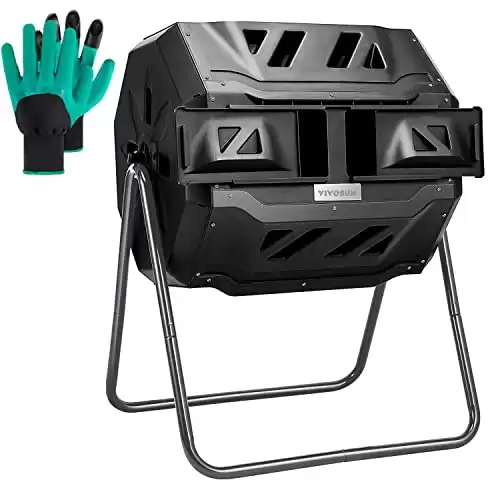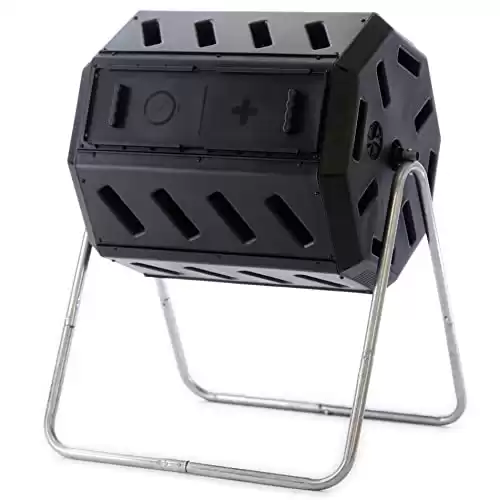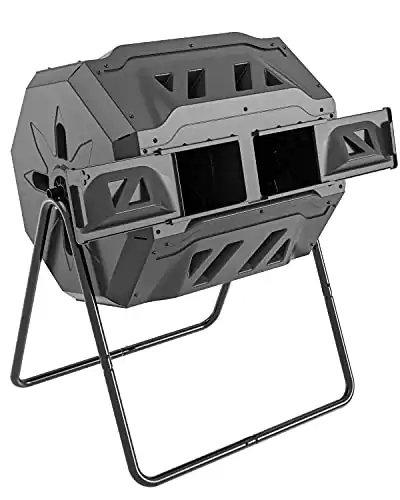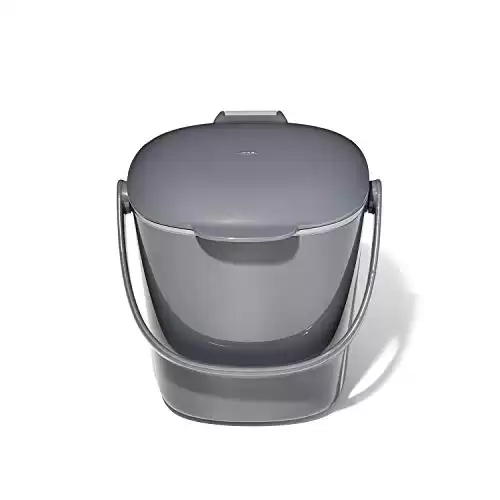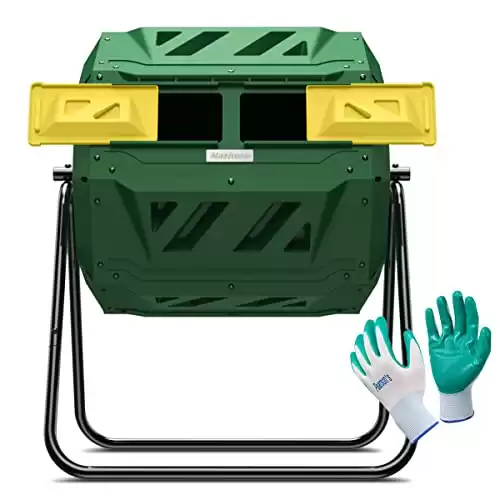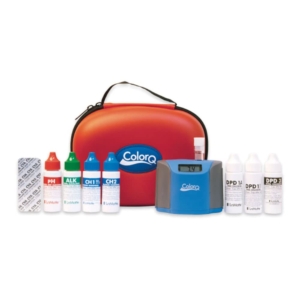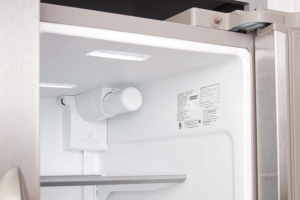Top Compost Bins: Exploring Types, Pros, Cons and Cost
Composting is an eco-friendly practice that not only helps reduce waste but also produces nutrient-rich soil for gardening. A key component of successful composting is choosing the right compost bin. In this blog, we’ll delve into the various types of compost bins, their pros, and cons, and provide an overview of their costs. By understanding these factors, you can make an informed decision and kick-start your composting journey.
Benefits of Compost Bins
Composting offers numerous benefits for both the environment and personal gardening efforts. Here are some key benefits of composting:
1. Reduces waste: Composting diverts organic waste, such as food scraps and yard trimmings, from landfills. This reduces the volume of waste sent to disposal sites and helps mitigate methane emissions, a potent greenhouse gas.
2. Enriches soil: Compost is a nutrient-rich soil amendment that enhances soil fertility. It improves soil structure, water retention, and nutrient availability, leading to healthier and more productive plants.
3. Promotes sustainable gardening: Using compost in gardens eliminates the need for chemical fertilizers, reducing reliance on synthetic additives and minimizing environmental pollution. Composting also supports organic gardening practices.
4. Enhances plant growth and disease resistance: Compost provides essential nutrients and beneficial microorganisms that enhance plant growth and aid in disease resistance. It helps establish a healthy soil ecosystem, fostering strong and resilient plants.
5. Conserves water: Compost improves soil’s water-holding capacity, reducing the need for irrigation. It helps prevent water runoff and erosion, promoting water conservation in gardens and landscapes.
6. Encourages beneficial organisms: Compost supports a diverse array of beneficial organisms, including earthworms, beneficial bacteria, fungi, and insects. These organisms contribute to soil health and nutrient cycling, promoting a thriving ecosystem.
7. Improves soil structure: Compost helps improve soil structure, especially in clay or sandy soils. It enhances aeration, drainage, and soil aggregation, creating a more favorable environment for plant roots.
8. Reduces the need for chemical pesticides: Healthy, well-nourished plants grown in compost-amended soil are more resistant to pests and diseases. This reduces the reliance on chemical pesticides, benefiting both the environment and human health.
9. Recycles nutrients: Composting allows for the recycling of nutrients from organic waste back into the soil. It closes the nutrient loop, minimizing the need for synthetic fertilizers and reducing nutrient runoff that can pollute waterways.
10. Promotes sustainable waste management: By composting, individuals actively participate in sustainable waste management practices. It reduces the overall waste footprint, conserves resources, and contributes to a circular economy.
Composting is a simple yet powerful practice that aligns with sustainable living and environmental stewardship. Its benefits extend beyond individual gardens, positively impacting the health of our planet and future generations.
Types of Compost Bins:
1. Stationary Compost Bins:
– Pros: Stationary bins are affordable, easy to set up, and ideal for small spaces. They come in various sizes, shapes, and materials such as plastic, wood, or wire mesh. These bins often have lids and access doors for easy waste addition and compost removal.
– Cons: Lack of aeration and slow decomposition are potential drawbacks of stationary bins. You may need to manually turn the compost to ensure proper decomposition.
2. Tumbling Compost Bins:
– Pros: Tumbling bins are designed for easy turning, which helps aerate the compost and accelerates the decomposition process. They are available in single or dual-chamber designs, allowing for continuous composting. These bins are suitable for those with limited physical strength or space constraints.
– Cons: Tumbling bins tend to be pricier than stationary bins. Additionally, their smaller size may restrict the amount of waste you can compost at once.
3. Worm Composting Bins (Vermicomposting):
– Pros: Worm bins, such as the popular Worm Factory 360, use red worms to break down organic waste efficiently. Vermicomposting is odorless and suitable for both indoor and outdoor use. Worm castings (vermicompost) produced by these bins are highly nutrient-rich and perfect for gardening.
– Cons: Worm composting bins require specific conditions, such as maintaining proper moisture levels and temperature control. It may take some time to establish a healthy worm population before significant composting can occur.
4. In-Ground Compost Systems:
– Pros: In-ground composting involves directly burying organic waste in designated areas within your garden. It eliminates the need for a physical bin and allows for natural integration with the soil. This method is cost-effective and works well for large-scale composting.
– Cons: In-ground systems may not be suitable for all environments, particularly those with limited garden space or urban settings. They may also attract pests if not properly managed.
Cost of Compost Bins:
The cost of compost bins varies depending on factors such as size, material, and design complexity. Here’s a general price range for each type:
1. Stationary Compost Bins: Prices typically range from $30 to $150, depending on size and material.
2. Tumbling Compost Bins: Prices can range from $70 to $300 or more, depending on the size, quality, and additional features like dual chambers or sturdy construction.
3. Worm Composting Bins: Vermicomposting bins usually range from $80 to $200, depending on the size, quality, and accessories included.
4. In-Ground Compost Systems: Costs for in-ground systems are minimal as they mainly involve creating designated composting areas in your garden.
1. The Envirocycle Composting Tumbler:
The Envirocycle Composting Tumbler is a top contender among compost bins for its efficiency and versatility. This compact and elegantly designed bin features a dual-chamber system, allowing you to continuously add waste while the composting process takes place in the first chamber. With a built-in mixing drum, composting becomes hassle-free, ensuring optimal aeration and faster decomposition. The Envirocycle is also known for its durability, ease of use, and excellent odor control, making it a popular choice among urban dwellers and those with limited space.
2. The FCMP Outdoor IM4000 Tumbling Composter:
For those seeking a larger capacity compost bin, the FCMP Outdoor IM4000 Tumbling Composter is an excellent choice. With a generous 37-gallon capacity, this bin accommodates a significant amount of organic waste. The dual-chamber design allows for efficient batch composting, where one chamber can be used while the other matures. The sturdy construction and sturdy base provide stability, while the tumbling feature ensures easy mixing and aeration. Additionally, the IM4000 features a unique design that promotes efficient heat retention, aiding in faster decomposition.
3. The Worm Factory 360 Worm Composting Bin:
If you’re interested in vermicomposting, the Worm Factory 360 is a popular option that combines convenience with eco-friendliness. This compact and odorless bin employs red worms to break down organic waste, creating nutrient-rich worm castings. The Worm Factory 360 consists of stackable trays, allowing the worms to migrate upward as they finish decomposing each layer. This system makes harvesting the compost and separating worms a breeze. Its compact size and ease of use make it an ideal choice for apartment dwellers or those with limited outdoor space.
4. The Algreen Products Soil Saver Classic Compost Bin:
The Algreen Products Soil Saver Classic Compost Bin is a traditional and budget-friendly option for composting enthusiasts. Made from 100% recycled material, this bin offers a generous capacity of 82 gallons, making it suitable for larger households. Its sturdy construction ensures durability and effective insulation for temperature control. The Soil Saver Classic features large access panels for easy waste addition and compost removal. This bin also boasts an efficient locking system that keeps animals out while preventing odors from escaping.
DIY – Do it YourSelf Outdoor Compost Bin
Here’s a list of the materials needed to create an outdoor compost bin:
1. Container (choose one):
– Wooden crate or pallets
– Wire mesh or hardware cloth
– Plastic bin or trash can with a lid
2. Tools:
– Drill with various drill bits
– Hammer
– Nails or screws
– Zip ties (if using wire mesh)
3. Ventilation:
– Drill with appropriate drill bits
4. Base material:
– Twigs
– Small branches
– Straw
– Coarse materials
5. Carbon-rich materials (browns):
– Dry leaves
– Shredded paper
– Cardboard
6. Nitrogen-rich materials (greens):
– Fruit and vegetable scraps
– Coffee grounds
– Tea leaves
– Fresh grass clippings
7. Water source:
– Hose or watering can
8. Composting tool (optional):
– Pitchfork
– Compost turning tool
These materials will help you construct an outdoor compost bin and provide the essential components for successful composting. Remember to choose a container that suits your needs and consider the size and location of your composting area.
Making your own DIY compost bin is a cost-effective and straightforward way to start composting. Follow these steps to create your own compost bin:
1. Choose a container: Select a suitable container for your compost bin. Options include a plastic bin with a lid, a wooden crate, or repurposed materials like pallets or barrels.
2. Prepare ventilation: Ensure proper airflow by drilling holes in the container’s sides and bottom. This allows for oxygen circulation, essential for the composting process.
3. Create a base: Place a layer of twigs, small branches, or straw at the bottom of the bin. This helps with drainage and prevents the compost from becoming too compacted.
4. Add compostable materials: Start by layering a mix of green and brown materials. Green materials include vegetable scraps, grass clippings, and coffee grounds, while brown materials include dry leaves, shredded paper, and cardboard.
5. Maintain moisture: Keep the compost moist, resembling a damp sponge. Regularly water the pile if it becomes dry, but avoid overwatering, which can lead to anaerobic conditions.
6. Turn the compost: Every few weeks, use a pitchfork or shovel to turn the compost pile. This helps aerate the materials, speeding up decomposition.
7. Patience and monitoring: Composting takes time, typically several months to a year. Monitor the moisture levels and temperature regularly, aiming for a temperature range of 120-150°F (49-66°C) for optimal decomposition.
8. Harvest the compost: Once the compost turns dark brown, crumbly, and earthy-smelling, it is ready to use. Remove any large, undecomposed materials and transfer the finished compost to your garden or potted plants.
Remember, composting is a natural process, and adjustments may be needed based on your specific conditions. With patience and care, your DIY compost bin will provide you with nutrient-rich soil for your plants while reducing waste and benefiting the environment.
Here are 10 frequently asked questions (FAQs) about compost bins:
1. Q: What can I put in a compost bin?
A: You can compost a wide range of organic materials such as fruit and vegetable scraps, coffee grounds, tea leaves, eggshells, yard waste (leaves, grass clippings), and shredded paper.
2. Q: Can I compost meat, dairy, or oily foods?
A: It is generally recommended to avoid composting meat, dairy products, or oily foods as they can attract pests and slow down the composting process. Stick to plant-based and non-greasy materials for best results.
3. Q: How long does it take for compost to be ready?
A: The time for compost to fully decompose varies depending on factors like temperature, moisture, and the mix of materials used. Generally, it can take anywhere from a few months to a year.
4. Q: Does composting smell bad?
A: Properly maintained compost bins should not produce strong odors. Good aeration and the right balance of materials will help prevent unpleasant smells. If there is an odor, it may indicate the need for adjustments in moisture or the addition of dry carbon-rich materials.
5. Q: Can I compost in an apartment or small space?
A: Yes, you can compost in small spaces using compact bins, such as worm composting bins or bokashi composting systems. These methods are well-suited for indoor or balcony composting.
6. Q: How do I prevent pests in my compost bin?
A: To deter pests, avoid adding meat, dairy, oily foods, or pet waste to your compost. Ensure the bin is securely covered, bury fresh food waste under the existing compost, and maintain a balanced carbon-to-nitrogen ratio.
7. Q: Can I compost leaves and grass clippings together?
A: Yes, a mix of leaves and grass clippings can be composted together. Layering them with other materials, like kitchen scraps or shredded paper, helps maintain a balanced compost pile.
8. Q: Is composting environmentally friendly?
A: Yes, composting is environmentally friendly as it reduces waste sent to landfills, decreases greenhouse gas emissions, and produces nutrient-rich soil that enriches gardens and reduces the need for chemical fertilizers.
9. Q: Can I use compost in potted plants?
A: Absolutely! Compost is beneficial for potted plants. It improves soil structure, retains moisture, and provides essential nutrients. Mix compost with potting soil or use it as a top dressing for potted plants.
10. Q: How can I troubleshoot common composting problems?
A: Common issues include compost that is too wet, too dry, or not decomposing. To troubleshoot, adjust moisture levels by adding water or dry carbon-rich materials, turn the pile for aeration, and ensure a proper balance of green and brown materials.
Remember, specific composting practices may vary depending on your circumstances and the composting method you choose.
Conclusion: Top Compost Bins
Whether you have limited space, prefer a specific composting method, or require a larger capacity, the market offers a variety of options to suit your needs. The Envirocycle Composting Tumbler, FCMP Outdoor IM4000 Tumbling Composter, Worm Factory 360, and Algreen Products Soil Saver Classic Compost Bin are among the best compost bins available, according to popular Google searches.
By incorporating composting into your routine, you actively contribute to reducing waste, enriching the soil, and promoting a sustainable future. Regardless of which compost bin you choose, remember that composting is a rewarding journey that benefits both you and the environment. So, let’s compost, reduce waste, and nurture the Earth, one bin at a time!


